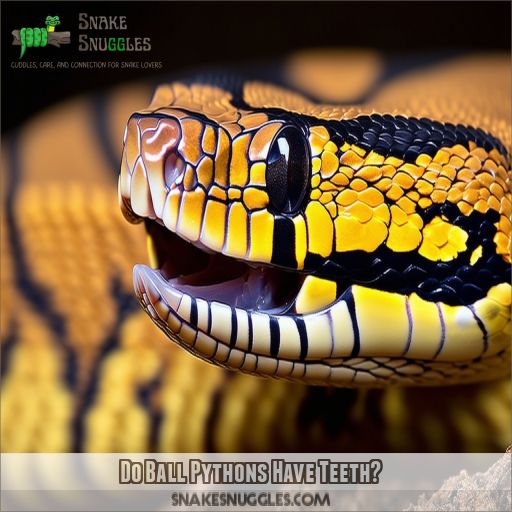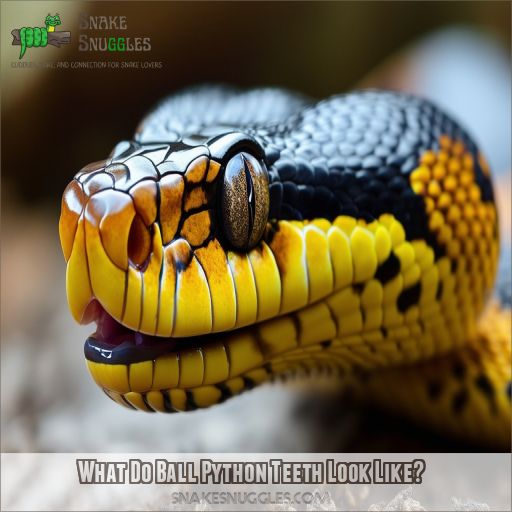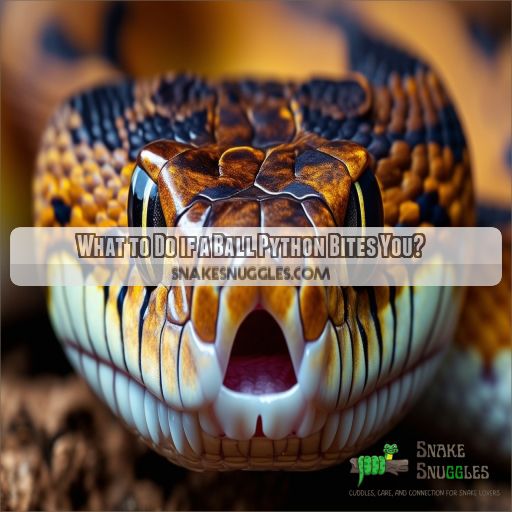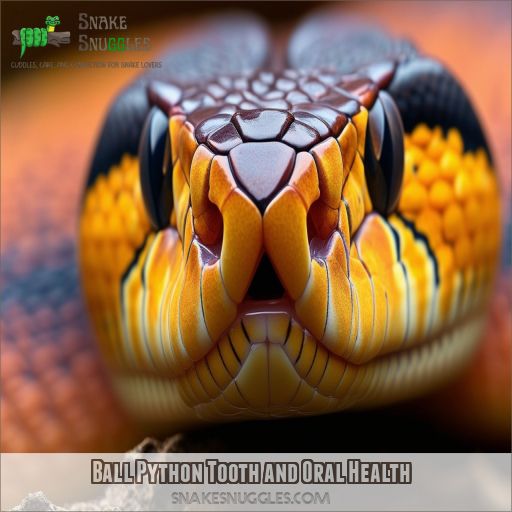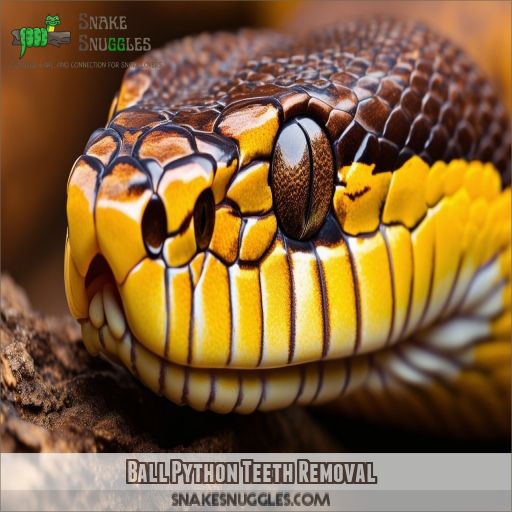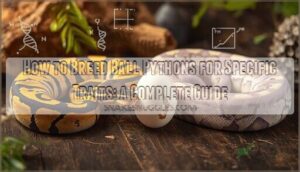This site is supported by our readers. We may earn a commission, at no cost to you, if you purchase through links.
 You might be surprised to learn that ball pythons have hidden teeth! These snakes typically possess 25-35 needle-like teeth, arranged in four rows on the upper jaw and two on the lower.
You might be surprised to learn that ball pythons have hidden teeth! These snakes typically possess 25-35 needle-like teeth, arranged in four rows on the upper jaw and two on the lower.
Ball python teeth are curved, hollow, and lightweight, yet strong enough to grip prey. They’re constantly being replaced throughout the snake’s life, ensuring a full set of sharp, functional teeth.
These chompers serve multiple purposes: gripping prey, guiding food down the esophagus, and aiding in swallowing larger meals.
While not venomous, ball python teeth can still deliver a painful bite if the snake feels threatened.
Understanding your pet’s dental anatomy can help you handle them more safely and confidently.
Table Of Contents
- Key Takeaways
- Do Ball Pythons Have Teeth?
- What Do Ball Python Teeth Look Like?
- How Many Teeth Do Ball Pythons Have?
- Why Do Ball Pythons Have Teeth?
- Is It Rare for a Ball Python to Bite?
- Why Do Ball Pythons Bite?
- What to Do if a Ball Python Bites You?
- How to Prevent a Ball Python Bite?
- Ball Python Tooth and Oral Health
- Ball Python Teeth Removal
- Frequently Asked Questions (FAQs)
- Does a ball python bite hurt?
- How many teeth does a ball python have?
- Is it rare for a ball python to bite?
- What do ball pythons’ teeth look like?
- Why do ball pythons bite?
- Do ball pythons have teeth?
- Why do ball pythons have curved teeth?
- Do pythons have dental problems?
- Can ball python teeth regenerate if lost or damaged?
- Do ball python teeth change as they age?
- How often do ball pythons shed their teeth?
- Are there differences in teeth between male and female ball pythons?
- Can ball pythons suffer from tooth decay or gum disease?
- Conclusion
Key Takeaways
- Ball pythons are packing some serious dental hardware! These slithery friends boast 25-35 needle-like teeth that are constantly being replaced. Talk about a lifetime supply of pearly whites!
- These chompers aren’t just for show – they’re curved and hollow, perfectly designed for gripping prey and guiding it down the hatch. It’s nature’s version of "don’t play with your food"!
- While bites are rare, they can happen if your python is stressed, shedding, or mistakes your hand for a tasty snack. Remember, a calm snake is a happy snake, so handle with care!
- Just like us, ball pythons can suffer from dental woes. Keep an eye out for signs of infection or abscesses, and don’t be afraid to book your scaly friend a dentist appointment if needed!
Do Ball Pythons Have Teeth?
Yes, ball pythons do have teeth! These fascinating reptiles possess a set of hidden fangs that play a vital role in their survival.
Unlike what you might expect, ball python teeth aren’t venomous when compared to other non-venomous snakes
. Instead, they’re specialized tools for gripping and swallowing prey.
As your snake grows, it’ll shed and replace its teeth, much like how you lost your baby teeth.
Understanding your ball python’s oral anatomy is essential to proper tooth care and preventing potential issues.
While bites are rare, knowing about their teeth can help you better appreciate your scaly friend’s unique adaptations.
What Do Ball Python Teeth Look Like?
Ball python teeth are curved and needle-like, designed to grip prey effectively. These teeth are also hollow and lightweight, allowing for efficient feeding without weighing down the snake’s head.
Curved and Needle-like Teeth
You’ll be surprised to learn that ball python teeth aren’t what you might expect. These fascinating creatures boast curved, needle-like teeth that are perfectly adapted for their lifestyle.
Each tooth is small, measuring between 1/8 and 1/4 of an inch, and points in the direction of the back of the mouth. This inward-sloped design isn’t just for show – it’s a result of millions of years of evolution, optimizing their bite for gripping prey.
Unlike some snakes with prominent fangs, ball pythons have a more uniform set of teeth. This dental anatomy plays a vital role in their feeding habits and defense mechanisms.
Hollow and Lightweight Teeth
You might be surprised to learn that your ball python’s teeth are hollow and lightweight. This unique tooth anatomy serves several important functions. The hollow structure allows for efficient nutrient distribution, while the lightweight design enables quick and precise strikes when catching prey.
Here are four fascinating facts about ball python teeth:
- They’re as thin as needles, yet strong enough to grip prey.
- Their hollow nature reduces overall weight, enhancing agility.
- The lightweight design minimizes energy expenditure during feeding.
- Despite their delicate appearance, these teeth are remarkably durable.
Understanding your snake’s tooth shape and function can help you better care for your scaly friend and appreciate their remarkable adaptations.
How Many Teeth Do Ball Pythons Have?
Now that you’ve seen what ball python teeth look like, you might be wondering just how many of these tiny daggers your scaly friend possesses. Well, hold onto your hats, because the answer might surprise you! Ball pythons typically have:
- 25-35 teeth in total
- 4 rows on the upper jaw
- 2 rows on the lower jaw
These needle-like teeth are constantly being replaced throughout the snake’s life. As they grow, break, or wear down, new teeth develop to take their place. This guarantees your ball python always has a full set of sharp, functional teeth for gripping prey and defense.
Why Do Ball Pythons Have Teeth?
Ball pythons have teeth for several essential functions related to their survival and feeding habits. Their teeth are key in gripping and holding onto prey, guiding food down the esophagus, aiding in swallowing larger prey items, and serving as a defensive mechanism when needed.
Feeding and Gripping Prey
Your ball python’s teeth aren’t just for show. These tiny, curved fangs are perfectly designed for gripping prey. When your snake strikes, its 25-35 needle-like teeth sink into the meal, preventing escape. This clever adaptation guarantees your python doesn’t lose its dinner mid-constriction.
Guiding Food Down the Esophagus
Your ball python’s teeth aren’t just for show. They guide prey down the esophagus with precision. These curved marvels, shaped like tiny needles, guarantee a smooth journey for food.
- Imagine rows of miniature hooks lining the mouth
- Picture a slippery rat sliding effortlessly down
- Envision teeth working like a conveyor belt for prey
Aiding in Swallowing Prey
| Function | Description |
|---|---|
| Grip | Teeth hold prey securely |
| Guide | Direct food to esophagus |
| Ratchet | Move prey deeper into mouth |
Defense Mechanisms
While swallowing prey is a vital function, your ball python’s teeth also serve as a defense mechanism. These curved structures can deter potential threats. If your snake feels cornered, it might use its teeth to protect itself. However, bites are rare and usually a last resort.
Is It Rare for a Ball Python to Bite?
Ball python bites are relatively rare occurrences, as these snakes are generally docile and prefer to retreat when threatened. However, bites can happen in situations of self-defense, stress, fear, or mistaken identity, especially if the snake feels cornered or is handled improperly.
Bites Occur for Self-Defense
You’ll be relieved to know that ball python bites are quite rare, especially in captive-bred specimens. These docile snakes typically resort to biting only as a last-ditch effort for self-defense.
Despite lacking venom glands, their bite can still be unexpected. To minimize bite severity, it’s essential to understand your snake’s body language and practice proper handling techniques.
No need for tooth extraction here – just a little snake sense!
Bites Due to Stress, Fear, or Mistaken Identity
You might wonder if your ball python’s bite is a common occurrence. While rare, these snakes can bite due to stress triggers, fear responses, or mistaken identity.
Your python’s defensive bites are rooted in self-preservation instincts. Unfamiliar scents, sudden movements, or feeling threatened can prompt a bite. Remember, your snake isn’t being malicious; it’s simply reacting to perceived danger.
Why Do Ball Pythons Bite?
Ball pythons may bite due to various factors, including their young age, improper handling techniques, or if they’re digesting a meal or shedding. You should also be aware that having the scent of prey on your hands can trigger a feeding response, potentially leading to a bite.
Young Age
Young ball pythons are more likely to bite than their older counterparts. Their inexperience and nervous temperament can lead to age-related bites. When handling baby ball pythons, extra caution is necessary to prevent stress-induced defensive reactions.
Improper Handling
When you handle your ball python improperly, you’re increasing the risk of a bite. Mastering safe handling techniques, creating a stress-free environment, and understanding feeding schedules are essential. Proper enclosure design also plays a role in reducing stress-induced bites.
Digesting a Meal
Even with proper handling, your ball python might bite while digesting. During this time, their tooth function is heightened. To avoid bites:
- Don’t disturb them
- Keep enclosure closed
- Avoid handling for 48 hours
- Watch for digestion signs
Shedding
During the shed cycle, your ball python’s skin health can make it more irritable. Maintain proper enclosure cleanliness and scale care to minimize stress. Be extra cautious handling your snake during this time, as it’s more likely to bite.
Scent of Prey on Hands
Your ball python’s scent sensitivity can trigger a bite if you’ve handled prey. To prevent this, always wash your hands thoroughly before handling. Here are key hygiene practices:
- Use unscented soap
- Rinse hands completely
- Avoid prey-scented lotions
- Wear gloves when feeding
- Change clothes if necessary
What to Do if a Ball Python Bites You?
If a ball python bites you, remain calm and resist the urge to jerk away, as this can cause more damage. Gently disengage the snake’s teeth, clean the bite area thoroughly with soap and water, apply an antiseptic cream, and monitor for any signs of infection.
Remain Calm and Avoid Sudden Movements
If your ball python bites, stay calm and avoid sudden movements. Their teeth impact can be surprising, but panic worsens the situation. Remember:
| Do | Don’t |
|---|---|
| Breathe deeply | Jerk away |
| Remain still | Scream or yell |
| Assess the bite | Punish the snake |
| Wait for release | Force removal |
| Seek help if needed | Ignore tooth decay |
Gently Disengage the Snake’s Teeth
Once you’re calm, gently remove the snake’s teeth. Their curved shape makes this tricky, so be patient. Don’t yank; instead, slowly roll the snake’s head forward. This aligns their teeth for easier removal without damaging them.
Cleanse the Area With Warm Water and Soap
After a ball python bite, cleanse the area thoroughly:
- Use warm water and gentle soap
- Rinse for at least 30 seconds
- Pat dry with a clean towel
This essential step helps prevent infection and promotes faster healing.
Apply Antiseptic Cream to Prevent Infection
After cleaning the bite, apply an antiseptic cream to prevent infection. This essential step in wound care helps protect against harmful bacteria. Here’s a quick guide to essential cleaning supplies and antiseptics for your first aid kit:
| Item | Purpose | Importance |
|---|---|---|
| Antiseptic cream | Prevent infection | High |
| Sterile gauze | Cover wound | Medium |
| Medical tape | Secure dressing | Low |
Monitor for Signs of Infection
After a ball python bite, watch for symptoms like redness, swelling, or discharge. The severity’s usually low, but take precautions. If you notice worsening signs, seek treatment. Prevention’s key, but knowing when to act guarantees your safety.
How to Prevent a Ball Python Bite?
To prevent ball python bites, handle your snake with care and support its entire body when holding it. You’ll also want to avoid handling after meals or during shedding, wash your hands thoroughly to remove prey scents, and make certain your python has a proper enclosure that meets its needs.
Handle Appropriately
When handling your ball python, remember these key points:
- Approach calmly
- Use slow, deliberate movements
- Support the snake’s body
- Avoid grabbing near the head
These practices respect your snake’s comfort and minimize the risk of defensive bites.
Support Full Body When Holding
When holding your ball python, support its entire body. This mimics their natural environment and prevents stress. Proper support reduces the risk of defensive bites, as your snake feels secure. Always remember, a comfortable python is a calm python.
Avoid Handling After Feeding or Shedding
After feeding or shedding, your ball python needs time to digest or complete the process. Avoid handling during these periods to prevent stress and potential bites. Here’s why:
- Digestion takes 24-72 hours
- Shedding lasts 1-2 weeks
- Disturbing them can trigger defensive behavior
Remove Prey Scent From Hands
Before handling your ball python, thoroughly wash your hands to remove any prey scent. This simple hygiene practice prevents scent transmission that could trigger your snake’s feeding response. Proper hand washing is essential for safe, stress-free interactions with your pet.
Provide Proper Enclosure
Provide a proper enclosure to minimize bite risks. Design it with strategic hide placement, appropriate substrate, and a temperature gradient. Maintain suitable humidity levels. This environment reduces stress, keeping your ball python calm and less likely to bite.
Ball Python Tooth and Oral Health
Your ball python’s oral health is essential, and it’s important to be aware of potential issues like broken teeth, oral abscesses, and stomatitis (mouth rot). These conditions can cause discomfort and eating difficulties for your snake, so regular check-ups and proper husbandry are critical to maintain your pet’s dental well-being.
Broken Teeth
While preventing bites is imperative, you should also be aware of your ball python’s dental health. Broken teeth can occur due to feeding mishaps or accidents.
Don’t worry, though – snakes naturally replace their teeth throughout their lives. If you notice a broken tooth, monitor it closely. Most times, it’ll fall out and be replaced naturally.
However, if complications arise, consult a reptile vet.
Oral Abscess
An oral abscess in your ball python can be a serious dental issue. It’s a localized infection that forms a pus-filled pocket, often caused by bacteria entering through damaged gum tissue or a broken tooth. Prompt attention is essential to prevent complications and guarantee your snake’s well-being.
- Watch for swelling around the mouth
- Look out for loss of appetite
- Notice any changes in behavior
- Check for discharge from the mouth
Stomatitis (Mouth Rot)
Stomatitis, or mouth rot, is a serious dental health issue for your ball python. It’s caused by poor mouth hygiene and can lead to tooth decay and gum disease.
Watch for redness, swelling, or pus in your snake’s mouth. If you spot these signs, consult a vet immediately.
Regular dental care checks can prevent this painful condition and maintain your python’s overall health.
Ball Python Teeth Removal
You might wonder if ball python teeth removal is ever imperative. While it’s not a common procedure, there are instances where tooth extraction becomes vital for your snake’s dental health.
Oral surgery may be required if your python develops a severe infection, abscess, or fractured tooth that can’t heal naturally. However, it’s paramount to understand that tooth extraction isn’t a routine part of dental care for these reptiles.
Always consult an experienced exotic veterinarian for proper diagnosis and treatment. They’ll assess your snake’s tooth anatomy and overall oral hygiene before considering any invasive procedures.
Frequently Asked Questions (FAQs)
Does a ball python bite hurt?
A ball python bite can hurt, but it’s usually more surprising than painful. You’ll feel sharp pinpricks and possibly some bruising. It’s not severe, but proper handling can help you avoid this uncomfortable experience altogether.
How many teeth does a ball python have?
You’re in for a toothy surprise! Ball pythons pack a whopping 25-35 teeth in their mouths. These small, curved needles point backward, helping them grip prey. They’re hollow and lightweight, measuring 1/8 to 1/4 inch long.
Is it rare for a ball python to bite?
Ball python bites are rare. You’ll rarely encounter aggression from these docile snakes. They typically bite only when stressed, frightened, or mistaken for prey. With proper handling and care, you can minimize the risk of bites.
What do ball pythons’ teeth look like?
Imagine holding a tiny, curved needle. That’s what ball python teeth resemble. You’ll find 25-35 of these small, sharp teeth in their mouth, pointing backward. They’re hollow, lightweight, and measure between 1/8 to 1/4 inch long.
Why do ball pythons bite?
Ball pythons bite for various reasons. You’ll find they’re typically defensive, triggered by stress, fear, or mistaken identity. They might chomp if they’re young, improperly handled, digesting, shedding, or smell prey on your hands. Understanding their behavior prevents bites.
Do ball pythons have teeth?
Yes, ball pythons have teeth. You’ll find 25-35 small, curved teeth in their mouth, measuring 1/8 to 1/4 inch. They’re needle-like, pointing backward, and help grip prey. Don’t worry; bites are rare and typically defensive.
Why do ball pythons have curved teeth?
You’d swear these snakes were born dentists! Ball pythons‘ curved teeth are nature’s perfect design. They’re angled backward to grip prey securely, making escape virtually impossible. This clever adaptation guarantees dinner doesn’t slip away mid-constriction.
Do pythons have dental problems?
You’ll find that pythons can experience dental issues. They’re prone to infections, abscesses, and tooth loss. Regular check-ups with a reptile vet are paramount. Proper diet and hygiene help maintain your python’s oral health.
Can ball python teeth regenerate if lost or damaged?
You’ll be glad to know that ball pythons can regenerate their teeth. They’re constantly shedding and replacing them throughout their lives. If damaged or lost, new teeth will grow in their place, ensuring your pet maintains a healthy bite.
Do ball python teeth change as they age?
As your ball python ages, you’ll notice its teeth don’t change much. They’re constantly being replaced throughout its life, ensuring a full set of sharp, functional teeth for hunting and eating prey.
How often do ball pythons shed their teeth?
You might be surprised to learn that ball pythons don’t actually shed their teeth! Instead, they replace them continuously throughout their lives. This process, called polyphyodonty, guarantees they always have sharp, functional teeth for gripping prey.
Are there differences in teeth between male and female ball pythons?
You won’t find significant tooth differences between male and female ball pythons. Their dental structure is remarkably similar, with both sexes sporting 25-35 small, curved teeth designed for gripping prey and guiding it down their throat.
Can ball pythons suffer from tooth decay or gum disease?
You’d think snakes would have stellar dental plans, right? Surprisingly, ball pythons can indeed suffer from tooth decay and gum disease. Poor diet, inadequate humidity, and bacterial infections can lead to dental issues, requiring veterinary care for these slithery friends.
Conclusion
Like hidden gems in a snake’s mouth, ball python teeth are fascinating structures that play significant roles in their survival. You’ve now uncovered the secrets of these serpentine chompers, from their anatomy to their functions.

